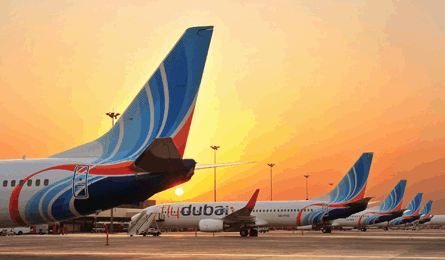The Gulf's embryonic low-cost airline sector received an injection from Dubai this year with the launch of the emirate's state-owned operation FlyDubai. And its arrival might just push major airlines from other parts of the region into a response.
Conceived to operate from the all-new airport at Jebel Ali, which had been due to open this year, the airline launched operations on 1 June from Terminal 2 at Dubai's existing international airport, just over 12 months after being established with a start-up capital of 250 million dirhams ($68 million).
Operating a one-type fleet of 189-seat Boeing 737-800s, the airline is operating to the established no-frills policy of low fares, point-to-point services with buy-on-board catering and high-density cabins. By the end of the year, six of the 54 737s it has on firm order will have been delivered. Another six will arrive next year and at least 10 more in 2011.
 |
|---|
© FlyDubai |
The Gulf's low-cost market is still in its infancy with only a handful of players, but that could be set to change. "There is big room to grow," says FlyDubai boss Ghaith Al Ghaith. "Just 3-5% of the capacity in this region is low-cost, compared with Europe, where it is 20%. I think more airlines will come, primarily as there are not enough right now."
The region's major established player is Air Arabia, based at Dubai's nearest neighbour Sharjah, which serves more than 40 points across the region with a fleet of 17 Airbus A320s. Kuwait-based Jazeera Airways launched in 2005 and has grown its A320 fleet to 10 aircraft, with orders outstanding for 30 more. It flies to 21 destinations.
The region has huge low-cost carrier potential because of its location, says Al Ghaith. "We live in the middle of almost three billion people. And if you can offer them this easy, low-cost way to fly, then most people will travel more."
However he warns that greater liberalisation is key to the low-cost carrier market fully realising its potential. And while broader open-skies deals will be an important part of this, easier access to certain markets from a border control perspective is also needed.
"Although it is getting better, in this region visa requirements can still make people less mobile when travelling from one country to another," Al Ghaith says.
Being state-owned, FlyDubai is effectively a sister company to Emirates - although there are no operational links between the two. If the low-cost threat grows, it could prompt a response from Emirates' rival Qatar Airways, which has warned it will spin off its own low-cost arm if its market share is being eroded.
This could happen sooner rather than later with news that FlyDubai's first intra-Gulf service, which beginlast month, will be to Qatar Airways' Doha base.
FlyDubai launched with services to Beirut and has had an encouraging start as it expanded its network to include Alexandria, Aleppo, Amman, Damascus, Doha and Djibouti. "The summer was better than we expected," says Al Ghaith, but he cautions that it is too early to use this as a reliable benchmark.
As FlyDubai expands, it is targeting points within a 4.5h radius of Dubai, says Al Ghaith, which makes Africa, the Indian subcontinent and the former Soviet Union within range.
"New routes will be primarily where there is an open sky agreement making access easier, and where the market is smaller and the major airlines don't operate," he says.
While there has been some cross-fertilisation between Emirates and FlyDubai - several executives have moved over, including Al Ghaith, who spent 22 years with the flag carrier - there is an arms-length relationship between the two.
"Emirates does not own FlyDubai, it is totally separate. For example we have our own operating licence," he says.
Al Ghaith says that part of the reason FlyDubai was originally planned for Jebel Ali was the lack of growth capacity at the existing airport. But the revised timing of the new airport, plus the expansion of Dubai International airport's capacity "finally got the relief it needed", prompting the airline to set up base at the existing airport. "We will remain here for the foreseeable future, but will look to see how we can take advantage of Jebel Ali."
So after an encouraging first six months FlyDubai is preparing for a less hectic time in 2010. "We took six aircraft in six months, so six in 12 months should be manageable," jokes Al Ghaith.
Source: Flight International























